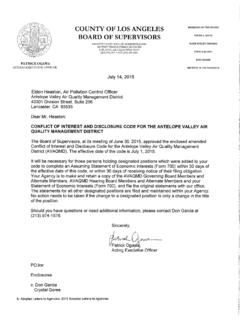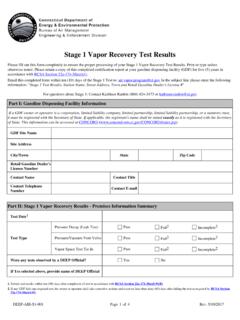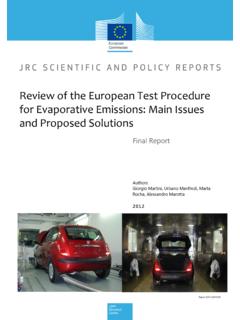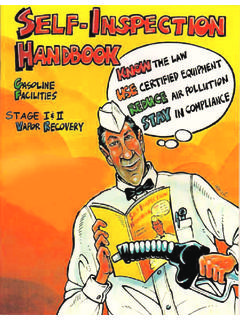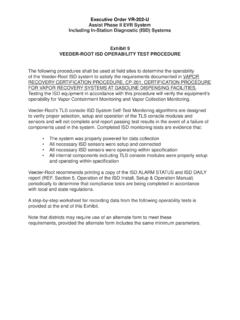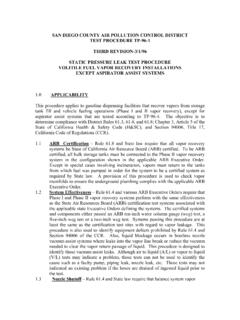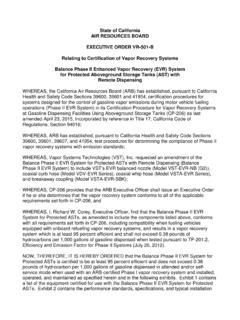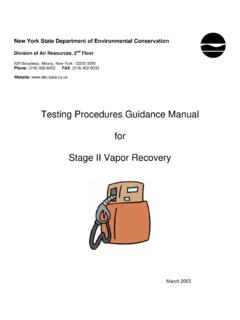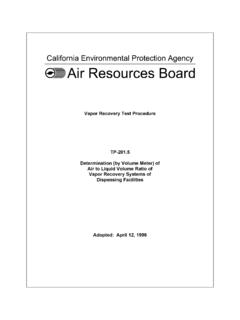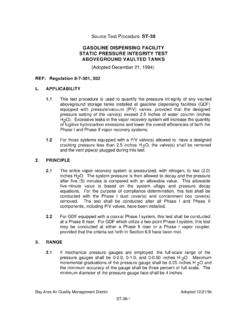Transcription of Test Procedure: 2002-07-03 TP-201.6C Compliance ...
1 vapor recovery Test Determination of Liquid Removal Rate Adopted: July 3, 2002 California Air Resources BoardJuly 3, , Page 1 California Environmental Protection AgencyAir Resources BoardVapor recovery Test Determination of Liquid Removal RateA set of definitions common to all certification and test procedures is in:D-200 Definitions for vapor recovery ProceduresFor the purpose of this procedure, the term "CARB" refers to the California Air Resources Board, andthe term "Executive Officer" refers to the CARB Executive Officer or his or her authorizedrepresentative or AND procedure is used to quantify the removal rate of liquid from the vapor passage of aPhase II balance system hose equipped with a liquid removal device.
2 This proceduredetermines Compliance with the performance standard defined in the CertificationProcedure CP-201 for the purposes of certification and for determining gasoline dispensingfacilities AND SUMMARY OF TEST test procedure provides two options to determine the Compliance of liquid removaldevices. Under option 1 (short version), liquid in the vapor path of a coaxial hose is drainedand measured. If the volume of liquid drained equals or exceeds 25 ml, a liquid removaltest is conducted. For those hoses with less than 25 ml drained, no further testing isrequired. Under option 2 (long version), all hoses are evaluated regardless of the volumeof liquid drained. Option 2 includes a prewetting and wall adhesion step.
3 Both options testthe liquid removal device by introducing gasoline into the vapor path of the coaxial hosethrough the nozzle bellows. After gallons of gasoline is dispensed, the amount ofgasoline remaining in the hose is measured and the liquid removal rate is determined. Thedistrict shall specify which testing option to be AND Slits or tears in the hose or nozzle vapor path may bias the results towards Any spillage of liquid when draining or introducing gasoline invalidates the A breach of the inner product hose may introduce additional gasoline into the outer vaporCalifornia Air Resources BoardJuly 3, , Page 2path resulting in a larger volume drained than Incorrect nozzle and/or hose orientation while dispensing invalidates the , RANGE, AND The range of measurement of the liquid removal rate is dependent upon the range of thegraduated cylinder used for testing.
4 To ensure precision, graduated cylinder readings shall be measured at the liquid Stopwatch. Use a stopwatch accurate to within Funnels. Large and small gasoline compatible, non-breakable, funnels with dimensionssimilar to those as shown in Figure 1, or Tape Measure. Use a standard tape measure with a minimum length of 5 Graduated Cylinders. Gasoline compatible, non-breakable 0-25ml, 0-100ml, 0-250 ml, and0-500 ml graduated cylinders with stable base plates. The 25ml cylinder may be necessaryto quantify volumes of liquid less than 20 Gasoline Test Tank. (Optional) A portable tank, meeting fire safety requirements for usewith gasoline, may be used to receive the gasoline dispensed during testing. The tankshall have sufficient volume so that at least gallons may be dispensed prior toactivating the primary shutoff mechanism of the nozzle.
5 The tank shall be constructed witha fill pipe opening meeting the specifications listed in Sections and of thisprocedure. To minimize testing-related emissions, vehicle refueling events should be usedfor this procedure whenever Traffic Cones. Use traffic cones to encircle the area where testing is Spout Measurement Angle Device. Use an angle measurement device to ensure the nozzlespout is resting in the vehicle or test tank fill pipe at an angle of 30 ( 5 ) degrees fromhorizontal during dispensing. A typical way to do this is to use a spout angle measurementdevice, as shown in Figure Field Data Sheet. Use the appropriate data sheet to record liquid removal test information. Form 1 and 2 serves as examples; districts may require a modified Gasoline Container.
6 Use a portable fuel container equipped with a tight fitting cap, of atleast gallon : THIS TEST PROCEDURE PROVIDES TWO OPTIONS TO DETERMINE Compliance OFLIQUID REMOVAL DEVICES. THE DISTRICT SHALL SPECIFY WHICH TESTING OPTION TO BECalifornia Air Resources BoardJuly 3, , Page 3 USED6. OPTION 1 (SHORT VERSION)PRE-TEST Verify that the 500 ml graduated cylinder is empty. Position the large funnel into thegraduated Remove the nozzle from the dispenser and carefully tilt the spout into the funnel/graduatedcylinder Lower the nozzle and funnel/graduated cylinder assembly as close to the ground aspossible. Walk out the hose while keeping the nozzle lowered and hose fully extended. The hose shall slope downward from the dispenser toward the Open the nozzle s vapor check valve by compressing the bellows.
7 Allow 60 seconds forall liquid to drain. Use caution to avoid Return the nozzle to the dispenser and measure the volume of liquid drained. If the volumedrained is less than 200 ml, transfer the liquid into an appropriately sized graduatedcylinder. For example, if 40 ml of liquid was drained, use the 100 ml graduated cylinder totake the Record the amount of liquid drained on Form If the volume drained is greater than or equal to 25 ml, proceed to Section of theprocedure. Hoses with greater than 25 ml drained are considered to be pre-wetted. If theamount drained is less than 25 ml, proceed to the next nozzle/hose to be evaluated andrepeat Section PROCEDURE (FOR HOSES WITH GREATER THAN 25 ML DRAINED) Pour 150 ml to 175 ml of gasoline into the 250 ml graduated cylinder.
8 Measure and recordthis volume on Form Remove the nozzle from the dispenser and position the nozzle upright so that the spout isin a vertical Open the nozzle s vapor check valve by compressing the bellows and carefully insert thestem of the small funnel between the bellows and nozzle Pour the measured volume into the vapor path of the hose. Use caution not to spill thegasoline (see Section ). Remove the small funnel after the gasoline has Position a vehicle or test tank fill pipe opening 48 ( 6) inches from the dispenser measuredperpendicular to the nozzle hanger and 30 ( 6) inches above grade. Use the tapeCalifornia Air Resources BoardJuly 3, , Page 4measure to verify these distances. See Figure Insert the nozzle into the fill pipe.
9 Use the angle measuring device to ensure the spout shallrest in the vehicle or test tank fill pipe at an angle of +30 ( 5 ) measured from horizontal. See Figure Dispense ( ) gallons at the highest possible flow rate by holding the nozzle lever inthe fully open position. Use a stopwatch to measure the time elapsed while dispensing. Record the volume of fuel dispensed and the elapsed time on a Form Calculate the dispensing rate using the equation below. If the dispensing rate is less gallons per minute (GPM), or a minimum rate approved by the Executive Officer asbeing consistent with normal operation, the test results are invalid. If the dispensing rateis greater than GPM the test results are :GPM= dispensing rate (in gallons per minute)G=gallons of fuel dispensedT= number of seconds required to Using the 250 ml graduated cylinder and large funnel, carefully drain the remaining liquidfrom the vapor path of the hose as described in Section through Record thisquantity on Form If the liquid removal rate is less than ml/gallon, but greater than or equal to , repeat the test two additional times and average the three OPTION 2 (LONG VERSION)
10 PRETEST Carefully pour 150 ml of gasoline into the 250 ml graduated Remove the nozzle from the dispenser and position the nozzle upright so that the spout isin a vertical Open the nozzle s vapor check valve by compressing the bellows and insert the smallfunnel between the bellows and nozzle Pour the gasoline from the 250 ml graduated cylinder into the vapor path of the hose. Usecaution not to spill the gasoline (see Section ). Remove the small funnel after thegasoline has been Verify that the 500 ml graduated cylinder is empty. Position the large funnel into thegraduated cylinder. =TG x 60 GPMC alifornia Air Resources BoardJuly 3, , Page Remove the nozzle from the dispenser and carefully tilt the spout into the funnel/graduatedcylinder Lower the nozzle and funnel/graduated cylinder assembly as close to the ground aspossible.


